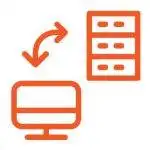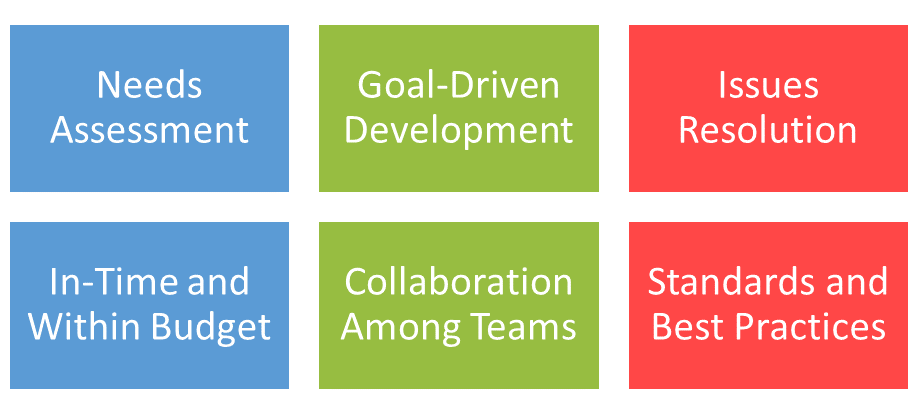Table of Contents
ToggleEveryone knows about digitalization and software development trends that assist activities like record keeping, accounting, workflows, sales, and customer services. Numerous industries utilize ERP and CMS solutions that follow and comply with business and taxation best practices. Oracle, SAP, and MS Dynamics comply with global standards like GAAP, IRS, ISO, COBIT, ITIL, and APICS.
However, every business, big or small, has a distinctive model and, thus, requires unique software development or customization. Custom software development relies on gap analysis, resource optimization, and solution design, signifying the need for a solutions architect. What is it? What do they do? How to become one? And most importantly, Why your business needs them? You might face such questions popping up, which we will try to answer in the subsequent sections. Further, we will address their differences with software engineers, solutions engineers, cloud architects, DevOps, and others for a better understanding.
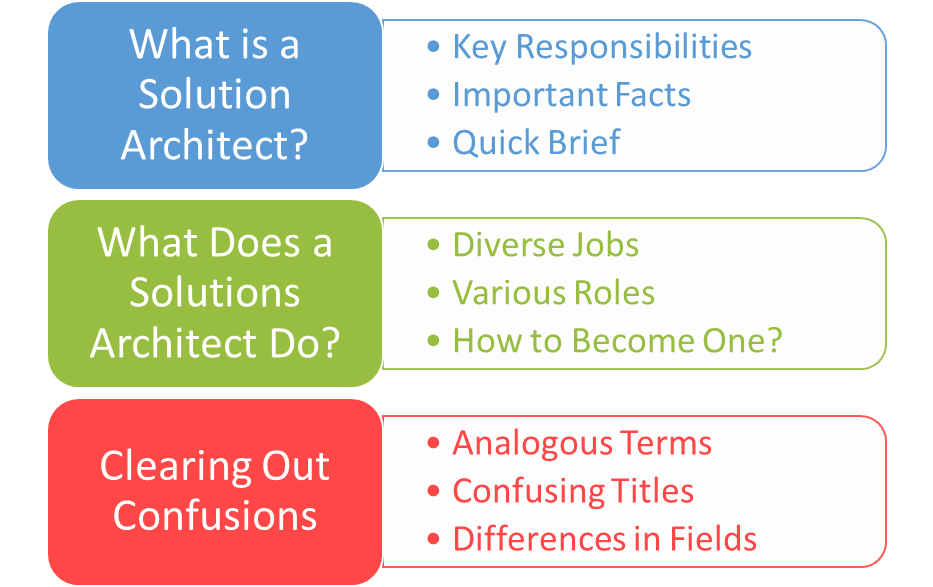
What is a Solutions Architect?
A professional solution architect assesses your organizational needs, facilitates scalability, and proposes software solutions. They plan the efficient utilization of resources, follow data policies and guidelines, and formulate a solution that brings effective results. Whether you require a solution for your firm or crafting one for your client, a solutions architect is central. Undermining or disregarding their need is the costliest mistake, which results in chaos and long-term disorder.
Key Responsibilities
Following are the key responsibilities of experts working in this field, with some variations. It will help identify the essential skills we will explain later under how to become a solutions architect.
1. Roadmaps and Blueprints
The first and foremost errand is to prepare a 360-degree development plan that serves as a roadmap for developers. It consists of the phases, components, and end goals of the project.
2. Design and Debugging
Another duty is to draft the overall layout for a responsive design and identify problems before development. Debugging refers to the optimization of design until the elimination of such issues.
3. Performance Optimization
A crucial responsibility is the performance optimization of software by speeding up its processing and workflows. It also covers the streamlining of task procedures by minimizing task repetitions.
4. Standard Procedure and Best Practices
Industries, states, and countries have legal or standard operating procedures and best practices. It’s another obligation that the technology solution must follow such standards and policies.
5. Managing Improvements and Upgrades
Improvements and upgrades are compulsory for every software and require timely attention. So, the responsible person must ensure provisions for future upgrades and modernizations.
6. Communication and Collaboration
Gathering insights, distributing information, and managing collaboration from all stakeholders is a must. The professional must establish a connection among all key personnel and assist them.
7. Facilitation in Project Lifecycle Stages
Each project goes through the stages of initiation, planning, execution, and monitoring. It is essential to facilitate all project lifecycle stages to get a user-driven and goal-oriented solution.
8. Validate and Prototype Latest Technologies
Opting for every emerging technology is not advisable, so they must validate the latest tech stack before use. Prototyping helps in presenting or selling solutions or collecting helpful feedback.
9. Integrations Between Software Components
Sometimes, more than one module or component needs integration with others for better results. Assuring a smooth integration is a vital task that guarantees the interfaces perform best.
10. Potential Risk Identification and Mitigation
Identifying potential risks and formulating mitigation strategies is an integral duty of an architect. It helps in risk management throughout the development and execution while avoiding issues.
Did You Know?
Over 50% of all ERP and custom software projects fail despite consuming more time and budget than allocated. Why? The reasons largely vary, but mostly, it’s due to poor execution, budget overruns, or failure to meet objectives. Moreover, in some cases, the software ends up causing more troubles than it solves, wasting more time, capital, and resources.
Consulting with professionals not only assures the project’s success but also reduces the chance of future issues for scalability. Companies can boost their return on investment by selecting the right software and deploying it correctly. Hire our unique software development services for business growth and expansion. Read the quick brief for an overview or delve further for details.
A Quick Brief
Architect definition, in simple terms, is the person who designs buildings and infrastructure for better construction. In contrast, IT solutions architecture refers to designing software solutions for businesses to get maximum benefits and attain necessary goals. An architect evaluates the objectives on standard parameters and outlines the scope of the custom development process. They find the best suitable solutions pertaining to organizational needs by addressing their impact on future growth and workload. It takes a collaborative effort among all stakeholders to define the solution’s scope and understand what is a solution and why it is necessary.
They focus on the root causes of problems that the company faces, outlining what is the solution to such issues. Furthermore, they assist the whole design process through solution architecture, determining how the components interact and work together. They coordinate with other design and development professionals to keep the project in line with requirements and goals. For instance, an ERP solution architect is responsible for implementing change while minimizing friction and managing resistance. Likewise, a software application architect helps develop tools and programs that increase productivity by reducing repetitive workflows and processing time.
If you want to explore further the roles, responsibilities, and expertise of such professionals, keep reading. We would explain solutions architect jobs and highlight their duties and expertise levels, clarifying how to become a solutions architect. Furthermore, we will address the concerns about similar titles such as software engineer, solutions engineer, cloud architect, DevOps, and others.
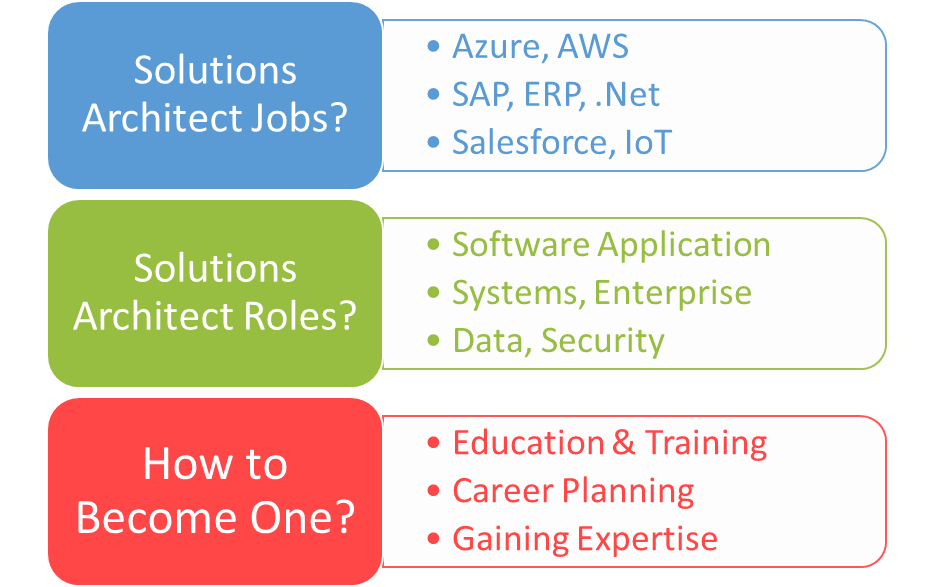
What Does a Solutions Architect Do?
Usually, they map the connections within different IT solutions and their components to perform solution feasibility. However, their duties and responsibilities stretch far beyond the traditional
architect definition. The following areas will address what they do, while the relevant fields of solution architecture will outline how they do it.
A. Solutions Architect Jobs
There are a number of jobs that constitute this domain based on categories and platform types. Azure, AWS, SAP, and Salesforce are a few of the famous platforms professionals use. Other types include technical, .net, data, security, enterprise, and IoT solutions. The aim of the software design and development project largely determines the professionals that might assist you. Several other genres of solution design require different professionals with relevant skills and experience. The following are the most in-demand jobs for various professionals in this domain.
1. Azure Solutions Architect
Microsoft Azure is a cloud-based, hybrid solution that entails expertise in computation, networks, storage, and monitoring. Azure solutions architect is the job title for the person who manages it.
2. AWS Solutions Architect Jobs
AWS solutions architect jobs include cloud solution design, efficient strategies, and collaboration with project teams. The powerful AWS cloud tool by Amazon also offers its certifications.
3. SAP Architect
The experience in SAP technical sizing and design allows a SAP architect to evaluate requirements and propose solutions. They provide integrations among different modules per client needs.
4. ERP Solution Architect
ERP solution architects work in line with the ERP project managers to facilitate implementation and performance enhancement. They usually switch roles to assist throughout the ERP project.
5. .Net Solution Architect
A Specialist who provides design, development, programming, and support consultation for web app development is a .net solution architect. C#, .net, HTML, CSS, and JavaScript are some of the most widely and commonly used languages.
6. Salesforce Solutions Architect
Designing organization-wide strategies and data models for Salesforce is the job of a Salesforce solutions architect. They help manage data, security, and integrations for large organizational systems while optimizing performance.
7. IoT Solutions Architect
The primary job of an IoT solutions architect is to define IoT vision, implement solutions, analyze data, and gather insights. They use them to optimize systems performance through automation.
B. Solutions Architect Roles
There are numerous roles that a professional might assume depending on the project phase and scope. The following functions define the aim of different jobs while answering queries like what does a software architect do.
1. Software Application Architect
Most people think designing a creative software solution is the only parameter to define what does a software architect do. A software application architect is also responsible for monitoring an application and understanding the functionality or limitations to enhance productivity.
2. Systems Architect
The experts create the right mix of technology solutions, assuming the role of systems architect. They work with multiple systems and their integrations to uplift the overall technical capabilities. Their high-end computing, coding, and IT infrastructure skills help produce premium solutions.
3. Enterprise Solutions Architect
The top-level position of the whole domain is an enterprise solutions architect, which oversees the implementation of solution mechanisms. They manage the overall IT infrastructure and software applications integration to address the various issues across all enterprise divisions.
4. Security Solutions Architect
The role of the security solutions architect is to protect the business from every security threat. They build the entire data protection and encryption designs to prevent data breaches and remove vulnerabilities to minimize risk exposure.
5. Data Solutions Architect
The core role of a data solutions architect is to create a database architecture that controls data quality and validation. They take requirements and plan the data entry points that only allow valid data for storage, processing, and decision-making.
C. How to Become a Solutions Architect?
There are many ways that support becoming a solutions architect, ranging from education to career choices. However, a diverse experience in computer science, IT, and business software is mandatory before you opt for it. The following domains are the most suitable to pursue this role.
1. IT Architect
The job description of an IT architect is to find effective IT solutions and maintain a robust IT infrastructure. They collaborate with the technical and non-technical resources to bridge the gap between them and attain efficiency. Databases, networks, and systems are all vital in IT solution design, so you can start a career in this domain to progress.
2. Technical Architect
Creating the blueprints for implementing or upgrading technical systems in an enterprise is the task of a technical architect. Communication with different teams and delegation of tasks to relevant personnel improves your coordination skills. Assuring compliance is another aspect of this role so you can prepare better for your transition to a senior architect.
3. Technology Architect
The fast pace of emerging technologies and innovations requires a particular skill set, needing a technology architect. Their profound knowledge in the technology solution domain, such as Java or Python, allows them to leverage the latest tech stack. A four-year degree will lend you a job in this field to gain desirable expertise, helping you to excel further.
4. Solutions Architect Expertise
No matter how technically sound, candidates will require a set of other essential skills to get to the desirable level. Business assessment, network diagnostics, hardware specifications, and interpersonal skills are compulsory for solutions architect expertise. Finding, implementing, and managing solutions is half the part, while the other half is maintaining efficiency and cohesion.
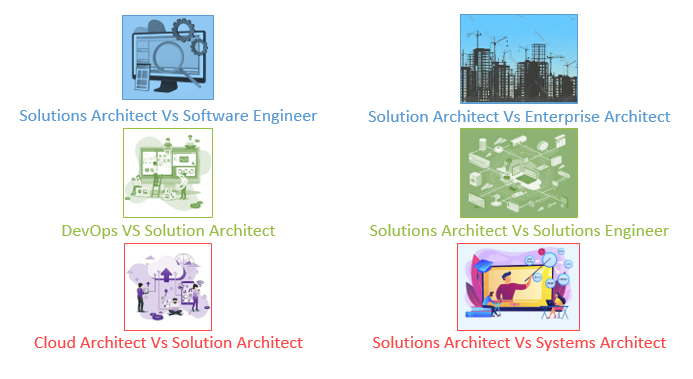
Clearing Out Confusion
There is vast haziness about the analogous terms and lookalike roles, which we will address here. The following comparisons will clear out confusion by defining the territories of other experts.
a. Solutions Architect Vs Software Engineer
Solution architecture is about knowledge of supportive software, while software engineering is about in-depth information on development. The core job of a software engineer is to use their skills in the relevant domain to solve underlying problems. For instance, if the former selects an option for a company, software engineers modify the solution following the given outline.
b. Solution Architect Vs Enterprise Architect
There can be many roles for specific areas like security, data, and integration, while all report to the enterprise architect. The earlier one resolves specific issues, while the latter aligns the overall IT strategy with the company’s objectives. Enterprise architects have the topmost position in the overall hierarchy of solution design planners of an enterprise.
c. DevOps VS Solution Architect
DevOps largely works within the domain of developing and refining deployment channels, aiding automation with scripting. While the territories mostly overlap, with no clear boundaries as cases differ from company to company, the latter has an edge. They can set the direction of future progress by considering the issues a business faces across multiple areas.
d. Solutions Architect Vs Solutions Engineer
Think of it as a building architect and engineer, where the architect designs the building, and the engineer builds it. Likewise, the prior designs the solutions and formulates its layout while the solution engineer builds it accordingly. The roles again overlap in certain areas, like assisting the design or development phase, but have entirely different scopes.
e. Cloud Architect Vs Solution Architect
This one is a little tricky to explain, but we try our best to reduce the vagueness. A cloud architect is a subset of the other domain where they perform similar tasks but on a cloud-based platform. It is safe to say that all SAs are not cloud architects, but all cloud architects are SAs. Amazon AWS and Microsoft Azure are the perfect examples of such cloud-based platforms.
f. Solutions Architect Vs Systems Architect
The former pertains to only the software aspect, while the latter has an additional responsibility for the hardware features. Systems architecture deals with the physical placement and incorporation of the solution on specific hardware, including IT infrastructure. They use the design blueprints and recommend the hardware components crucial for executing the plan.
Why Does Your Business Need a Solutions Architect?
We are about to conclude our journey to understand the different roles and responsibilities of solution architects. It would be unjust not to mention the benefits that professionals are capable of providing. A quick review of the advantages of hiring solution architects won’t take much time.
a. Assessing the Technical Business Needs
Most of the businesses understand the importance of management consultants and business administration. However, they lack the knowledge of technical business needs that necessitate consultation with relevant mavens. Technical requirements are crucial in the digital marketplace, where negligence costs you a fortune. Experts not only assist you in assessing the technological needs but also propose the best suitable technology to win over the competition.
b. Goal-Driven Strategy for Development
Not only do they propose suitable software or its components, but they also provide a thorough plan for it. The goal-driven strategy for development ensures a frictionless implementation while seeking participation from stakeholders. Resistance to change lowers while the developers gain a better perception of what the end users want in the application. User-centric development combines with user-friendly design, which leads to the project’s success by attaining goals.
c. Identify and Resolve Potential Issues
The vast experience and core expertise of specialists allow them to identify potential issues beforehand and address them. Early assessment of such matters enables finding the root causes so they embed the resolution mechanisms even before development. The development time is mainly reduced with clear boundaries for development teams, preventing conflict and delay.
d. In-Time and Budget Friendly Deployment
By providing a timeline for each development phase and accounting for the cost of components, they save significant costs. It is a fact that most projects surpass the time and budget restraints but still fail on a long-term basis. Considering this, professionals in this domain will ensure you get desirable results on time and within budget. It will help in cost reduction, time-saving, and effective deployment using efficient resource optimization.
e. Collaboration with Non-Technical Resource
One additional advantage of hiring a proficient is that they assist the communication between technical and non-technical teams. It ensures collaboration with all stakeholders irrespective of their technical knowledge, so all key personnel contribute to the project. Sometimes, the most insightful opinions may come from an ordinary resource, so it’s good to have them on board. It also gains their consent and support for project success as they feel a vital part of development.
f. Comply with Standards and Best Practices
Every now and then, we find companies ending up in legal trouble or penalties for failing quality or tax compliance. Another benefit of hiring the appropriate resource is that they assure full compliance with such standards and policies. By choosing the right tools and software, they help follow the standard legal, reporting, and operations guidelines, avoiding repercussions. They assist in the implementation as well as support to help achieve the desirable targets.
Conclusion
Developing and implementing a creative software solution takes more than finding developers and assigning tasks. It requires a complete understanding of organizational needs, technological aspects, available resources, and accessible solutions. Moreover, the expertise necessary for an effective solution design will bring success to custom development or implementation projects. The definition, scope, roles, and skills of a solutions architect will aid in understanding their job. The responsibilities and procedure to start will guide your endeavor to learn the necessary skills.
If you want to hire one, we offer design and development via the best solution architects in the US. The writing also clears up confusion for further understanding the subject matter and deciding your precise aim. Explore the benefits of hiring an expert and choose the relevant resource for your unique business needs. Unique Software Development serves the business community as well as learners through their high-end services and supportive blogs. Contact us for more information and precise estimates to lead your business to the leadership echelon.







